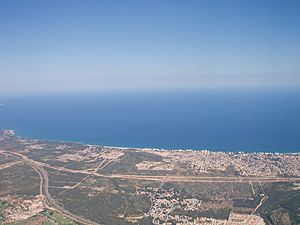Miami Platja facts for kids
Miami Platja (pronounced "mee-AH-mee PLAH-jah") is a sunny coastal town in Spain. Its name means "Miami Beach" in Catalan, the local language. It's located on the beautiful Mediterranean Sea, about 30 kilometers (18 miles) south of a bigger city called Tarragona. This area is in southern Catalonia, a region known for its unique culture and language.
Even though it's a separate town, Miami Platja is actually part of a larger area called the municipality of Mont-roig del Camp. This main town is about 20 kilometers (12 miles) away. Miami Platja is also very close to another municipality, Vandellòs i l'Hospitalet de l'Infant, right across the Llastres river.
Miami Platja is a very popular place for holidays. It has many holiday apartments and villas, which are like vacation homes. There are also a few hotels for visitors. A large part of the town is filled with these holiday homes, built in neat rows along wide streets, perfect for people enjoying the sun and sea.
Contents
What is Miami Platja Like?
Miami Platja is known for its lovely beaches and coves. The coastline here is quite varied, with long sandy stretches and smaller, more private rocky coves. This makes it a great spot for different kinds of beach activities, from sunbathing to exploring.
Beaches and Coves
The town boasts several beautiful beaches. Some are wide and sandy, perfect for families to play and swim. Others are smaller, hidden coves nestled among rocks. These coves offer a more peaceful experience and are great for snorkeling or just relaxing away from bigger crowds. The clear waters of the Mediterranean Sea are inviting for all kinds of water sports.
Holiday Homes and Tourism
Tourism is very important to Miami Platja. Most of the buildings you see are holiday homes. These are often rented out to people visiting for their vacations. The town is designed to welcome tourists, with many services and activities aimed at making their stay enjoyable. This focus on tourism means the town can be very lively during the summer months.
Getting Around Miami Platja
Miami Platja is well-connected by roads, making it easy for people to visit. Two main highways run close to the town. These roads help connect Miami Platja to other cities in Spain and even other parts of Europe.
Main Roads and Transport
The A-7 and the AP-7 (which is also part of the E15 European road network) are the two major roads near Miami Platja. The A-7 is a free highway, while the AP-7 is a toll road. These roads run inland, away from the coast, and help people travel quickly to and from the area. There is also a coastal road and a railway line that run closer to the sea, connecting the town to nearby places.
History of the Area
The area around Miami Platja has a long history, like much of Catalonia. While Miami Platja itself is a more modern development, the wider region has been inhabited for thousands of years.
Early Settlements
Evidence of ancient settlements can be found in the broader Mont-roig del Camp municipality. This shows that people have lived and worked in this part of Spain for a very long time. The rich history of the region adds another layer of interest for visitors who like to explore beyond the beaches.
Things to Do in Miami Platja
Besides relaxing on the beach, there are many other activities for young people and families in Miami Platja.
Water Sports and Activities
The Mediterranean Sea offers many opportunities for fun. You can try swimming, snorkeling, or even paddleboarding. Some places might offer jet skiing or boat trips. The calm waters are often perfect for trying out new water sports.
Exploring Nature
The area around Miami Platja has natural beauty beyond the beaches. You can find walking paths and trails that let you explore the local landscape. This is a great way to see different plants and animals that live in the Mediterranean climate.
Local Culture and Food
Being in Catalonia, Miami Platja offers a taste of local Spanish culture. You can try traditional Catalan dishes in local restaurants. Exploring the town and nearby villages gives you a chance to experience the local way of life and traditions.
See also
 In Spanish: Miami Playa para niños
In Spanish: Miami Playa para niños


